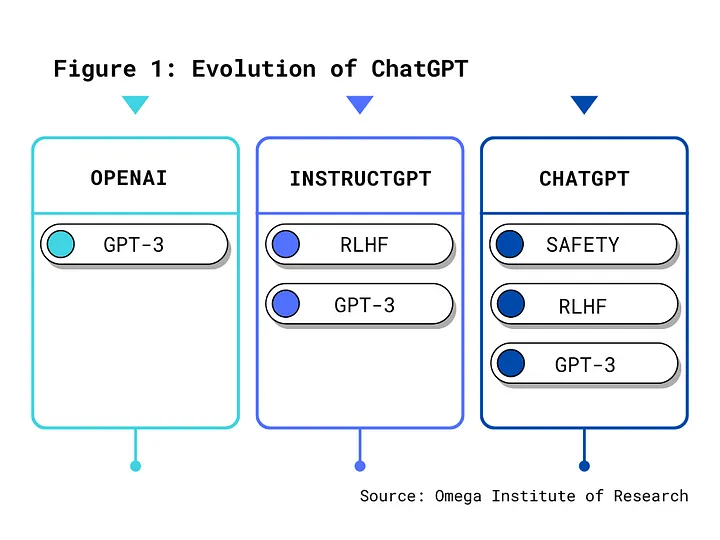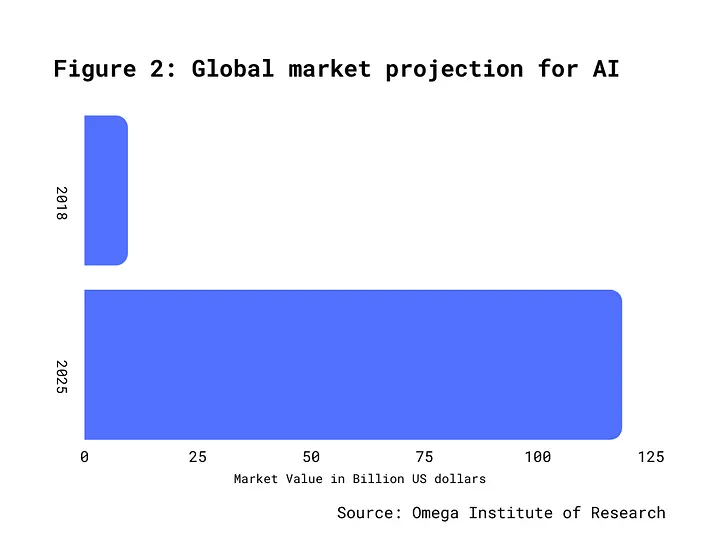- Industries
Industries
- Functions
Functions
- Insights
Insights
- Careers
Careers
- About Us
- Technology
- By Omega Team

Chatbot technology is nearly everywhere, from smart speakers at home to business chat apps. The most recent artificial intelligence chatbots are “virtual assistants” or “virtual agents.” They can engage with you via text or audio input, such as Apple’s Siri, Google Assistant, and Amazon Alexa. You can ask conversational questions about what you need, and the chatbot can help you refine your search through responses and follow-up questions. Chatbots have evolved throughout time to incorporate additional rules and natural language processing, allowing end users to interact with them conversationally. The most recent chatbots are contextually aware and can learn as they get exposed to more and more human language.
Today’s AI chatbots use natural language understanding (NLU) to determine the user’s needs. Then, they determine what the user is attempting to do using advanced AI technologies. These technologies rely on machine learning and deep learning — AI aspects with subtle differences — to build an ever-increasing knowledge base of questions and responses based on user interactions, enhancing their ability to foresee consumer needs and respond appropriately over time effectively.
What is ChatGPT?
A brand-new artificial intelligence chatbot known as ChatGPT belongs to OpenAI, a non-profit company started in 2015 by Altman, Musk, and other Silicon Valley investors to research more on artificial intelligence.
ChatGPT provides users with conversational responses to their questions and accepts directions from them like human interaction. The artificial intelligence language model “is indeed a sibling” to InstructGPT, which gives a response in detail to a user’s instructions.
How does ChatGPT work?
ChatGPT uses Reinforcement Learning from Human Feedback (RLHF) to optimize communication. ChatGPT responses seem human-like since they have trained on massive volumes of data produced by Humans. GPT (Generative Pre-training Transformer) is a transformer-based generative language model. The model uses transformations and attention to process sequences of elements, such as words in a sentence. This design efficiently completes natural language processing tasks that can read, understand, interpret, and reply to natural human language in meaningful ways.
These models can efficiently analyze massive quantities of text and learn to execute natural language processing tasks. The GPT-3 model has 175 billion parameters, making it the most prominent language model ever trained. GPT must be “trained” on a significant volume of text. The GPT-3 model, for example, was introduced on a text set including over 8 million documents and over 10 billion words. The model learns to execute natural language processing tasks and generate coherent, well-written prose from this text. As we saw in the last section, GPT helps perform a wide range of tasks if the model is well-trained.

Global Market Opportunities
Organizations utilize chatbot technology to save time, money, and workforce. Most firms deploy conversational bots in after-sales and customer support, followed by CRM, sales, and marketing. On the receiving end, as of 2017, consumers had the highest level of acceptability for using chatbots in the online retail business and the lowest level for using AI technology by government agencies.
In 2025, the market projection for chatbots to reach over 1.25 billion U.S. dollars, a significant increase from 2016’s market size of 190.8 million U.S. dollars. In 2018, the global market for AI software was valued at 9.51 billion U.S. dollars, and it is anticipated that this figure will increase to 118.6 billion U.S. dollars by the year 2025.
Natural language processing (NLP), machine learning, and robotic process automation are just a few of the AI market’s diverse uses. Microsoft, IBM, Google, and Samsung, four of the most prominent names in the IT industry, have invested extensively in AI-related research and development and submitted hundreds of patent applications.

Market Opportunities for ChatGPT
In light of this new technology, organizations must evaluate their work, what products and services they offer, and how artificial intelligence, such as ChatGPT, could improve workflows and customer experiences. Companies that strategically employ technology can capitalize on vast prospects made possible by tools such as ChatGPT. Chat-based artificial intelligence has the potential to enhance the way humans operate by automating mundane jobs and delivering more exciting interactions with users.
It can be used efficiently for the purposes like Arranging the findings of a study, Creating the material for marketing campaigns, Ideas generated through brainstorming, the process of writing computer code, automation of certain aspects of the sales procedure, providing customers with aftercare, offering individualized step-by-step directions, streamlining and improving processes through the utilization of automation, converting the text to another language and also streamlining the process of bringing new customers on board. Customer service is a vast opportunity for many businesses. Using ChatGPT technology, companies may produce responses for their customer care chatbots, allowing them to automate various jobs traditionally performed by people and drastically reduce response time.
35% of consumers want more companies to use chatbots, according to a survey by Opus Research. In comparison, 48% of consumers have no concerns about whether a human or an artificial chatbot assists them with a customer support inquiry. ChatGPT can be used where natural-sounding language based on input data is required. Conversely, AI-based chatbots’ benefits might become dangerous if your competitors successfully implement the technology and your business does not. Increasing consumer involvement will lead to increased customer loyalty and retention.
Concerns about ChatGPT
Inadequate comprehension of context and previous information
One of ChatGPT’s weaknesses is it’s unclear context and background information comprehension. This inability can be a disadvantage when a specific domain or industry where language comprehension is critical.
Difficulty comprehending sarcasm and irony
Another constraint is the difficulty in comprehending, identifying, and generating sarcasm and irony. This constraint is because Chat GPT is built on a text dataset and may miss the non-literal meaning behind words.
Lack of common sense and information
Chat GPT also needs more common sense and general knowledge, which might hinder specific applications like question- answering and problem-solving. Rather than interpreting the world through common sense, the model works on statistical patterns and correlations.
Inadequate ability to comprehend and answer complicated questions
Finally, Chat GPT’s ability to grasp and react to complex inquiries is restricted. While it can generate precise and fluent responses, it may need to comprehend the subtleties of a topic and deliver a complete and accurate answer for issues requiring logic, abstract thinking, and comprehension of diverse viewpoints.
Use of Chat GPT Bias in Training Data: Ethical Considerations
One of the most severe ethical concerns with Chat GPT is bias in the training data. Because the model functions on a large text dataset, data biases reflect in the model’s output. These data biases can result in unjust and erroneous outcomes, especially for vulnerable populations. A broad and representative dataset is essential for mitigating bias and ensuring fair and accurate results.
Misuse and exploitation of technology
Another ethical problem is the possibility of technology misuse and abuse. Chat GPT can generate human-like writing, which detects malevolent objectives like distributing misinformation or impersonating people. It is critical to have protections in place to avoid such misuse and to hold those who do so accountable.
Effects on job displacement and human interaction
Using ChatGPT may result in job displacement and a lack of human interaction. As technology advances, utilization to automate certain functions previously performed by humans. Evaluating the impact on workers and offering solutions, such as retraining programs or new career prospects, is critical.
Concerns about privacy and security
Concerns about privacy and security are also significant ethical considerations when utilizing Chat GPT. Because the model generates text based on the input it gets, it may divulge sensitive information inadvertently. Furthermore, using the model’s output to track and profile individuals to secure user data and avoid misuse. It is critical to have strong privacy and security measures.
Developers, users, and society all have responsibilities.
Finally, when utilizing Chat GPT, developers, users, and the community must have responsibilities. Developers must ensure training on diverse and representative data and that protections are in place to avoid misuse. Users are responsible for using technology ethically and suitably. And society as a whole bears responsibility for considering the consequences of technology and regulating its usage as needed.
Future of ChatGPT
The release of ChatGPT 4 might take place in the following months, and it is not only better than ChatGPT 3 but also does a lot more. While there has been no official confirmation of the beta testing of ChatGPT 4, it is expected to be one of the most capable AI-powered chatbots when it becomes available ChatGPT 4 might feature a whopping 1 trillion parameters, making it even more intelligent.
The parameter increase should allow ChatGPT 4 to deliver more accurate responses at a much faster rate. When a user submits a query to ChatGPT 4, it is processed using all 1 trillion parameters to get a precise result. ChatGPT 4 might demand more excellent computer capability. Therefore OpenAI may have to spend a lot to keep ChatGPT 4 functioning, and a commercial application based on ChatGPT 4 may be slightly pricey. On top of these capabilities, customer service and education services distinguish ChatGPT 4 from its predecessor. These capabilities suggest that ChatGPT 4 will be a fine-tuned version of ChatGPT 3, ready for commercial implementation in 2023.
Conclusion
We must recognize that advanced general AI intelligence is rapidly nearing reality. According to Reuters, OpenAI will generate more than 1 billion US dollars in revenue by 2024, indicating that the markets highly support it. What is certain is that ChatGPT will impact knowledge workers and the future of employment as AI becomes more prevalent.
Artificial intelligence might displace up to one billion people globally over the next decade and render 375 million jobs redundant. Because newer, better-paying occupations are unlikely to replace those lost, many ordinary people will need mass retraining and re-skilling to obtain new work. Economists are concerned about the consequences of ChatGPT on democracy, citing the capacity to write automated comments to influence the decision-making process for new legislation.
Subscribe
Select topics and stay current with our latest insights
- Functions